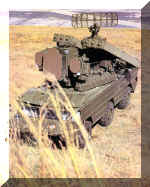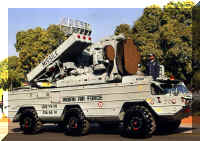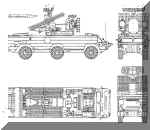Weapons
OSA-AKM
- Details
- Created: 12 October 2006
- Written by Anti Aircraft - (Self Propelled - Wheeled)
- Hits: 11880
Note: The Indian Army has decided to upgrade it's OSA-AKM air defence systems, due to inordinate delays in the Trishul missile program which was supposed to replace the OSA-AKM system. The $200 million upgrade program for 50 OSA-AKM [and 100 Kvadrat] systems is being done by Warsaw-based Centrex Trading Limited, Poland's state-owned agency for defence exports, and would be completed by 2002-end. The upgrade package includes replacement of both air defence systems' radars, signaling equipment and radio receivers. The package also includes new digital fire-control and power-pack systems. It is unclear at this point, whether the IAF has also decided to upgrade it's OSA-AKM air defence systems..
The SA-8b Gecko is a single-stage, solid-fuel, short-range, low-altitude, all-weather SAM. The TELAR vehicle is six wheeled with driver's compartment at the front of the vehicle which has accommodation for two; the driver and commander, with access to it via a hatch in the roof. The engine is at the rear. Four command-guided missiles are carried ready to launch, two either side. The main, conical-scan, fire control radar is at the rear of a one-man, gunner-radar operator position and folds back 90º to reduce the overall height of the vehicle for air transport and during high speed road travel.

An OSA-AKM system, based at Adampur AFB. [Image ?? Touching the Sky, P.S. Chopra] |

An OSA-AKM system at the 2001 Republic Day. [Image ?? MoD Report, 2000-01] |
The radar operates in the H-band with a 360º traverse and has a max. range of 35 km. Each battery also has two missile transloaders based on the same chassis with a long coffin-like blunt pointed tarp roofed structure covering the cargo space and crane. When operating, the blunt point area is raised and the tarped structure is slid to the rear. A total of 18 reloads in boxed sets of three are transferred to the TELAR by a hydraulic crane mounted centrally behind the vehicle cab. In the regiment maintenance battery there is a single radar collimation vehicle using the same chassis. This has a collimation antenna which lies on both sides of the vehicle and overhangs the rear during transit. It is raised during operation and mounted on each side of the hull directly behind the cab.
In operation it is raised and mounted on each side of the hull directly behind the cab. The SA-8b is contained in a rectangular launch box it has improved guidance and speed characteristics to give it a maximum range of 15km. The warhead weight of the missile is 19kg. The reloading time is five minutes. Combat deployment time is four minutes with the system reaction of 26 seconds. The surveillance radar operates in the H-band and has an effective range of around 30 km against a typical target. The tracking radar is of the pulsed type and it operates in the J-band with a range of 20 - 25 km. The I-band guidance radar makes it possible to launch two missiles at the same target, each one responding to a different frequency to frustrate ECM.

An all-view line drawing of the OSA-AKM. |

Firing missiles, along the coast of Mumbai.
|
Mounted on top of each missile guidance radar is an LLLTV/optical assist system for target tracking in low visibility and heavy ECM. The radar is also known to have a short-range target acquisition capability. The vehicle is fully amphibious, being propelled in the water by two water jets at the rear of the hull. The vehicle is fitted with an air filtration and over pressure NBC system together with IR systems for the commander and driver. The SA-8b can have six missile canisters with a reconfigured rear end. In 1991, the SA-8b TELs were seen with an additional small sized radar antenna fitted above the surveillance radar. It is possible that the antenna may be associated with a new IFF system.